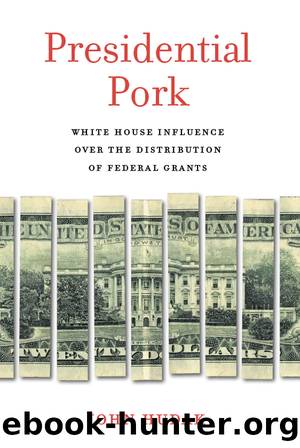Presidential Pork: White House Influence Over the Distribution of Federal Grants by John Hudak

Author:John Hudak [Hudak, John]
Language: eng
Format: epub
Tags: Leadership, Political Science, Political Process, Executive Branch, American Government, General
ISBN: 9780815725206
Google: wL0WAwAAQBAJ
Goodreads: 18096449
Publisher: Brookings Institution Press
Published: 2013-11-29T00:00:00+00:00
Beyond the Stimulus: Standard Federal Funding during the Great Recession
The observations about the distribution of stimulus grant dollars raise a couple of questions about non-stimulus funding during the same period. Did the same presidential and congressional forces that affected stimulus funding influence other federal funding? Did the economic and political situation facing federal agencies in 2009â11 generate unique behaviors in distributing non-stimulus grant dollars? There is theoretical support for multiple answers to those questions.
Programs were not redesigned because of the recession and ARRA; in fact, for the most part stimulus funding was piled on top of existing agency appropriations. One might therefore expect agencies to operate according to standard procedures, which, as prior chapters demonstrate, are influenced by the president, Congress, and state demand. In that case, the distribution of non-stimulus funds should reflect many of the theoretical expectations and empirical results found in chapter 3. However, federal agencies and grant programs are not locked into procedures that prevent them from responding to the political, economic, and social conditions of the day. In fact, policy success, particularly with regard to federal funding, flows from the ability to change with changing needs, whether economic, political, or electoral. Given the additional demands that economic conditions placed on the federal government after 2009, one would expect some responsiveness in federal funding. Although ARRA faced a unique blend of challenges and demands, non-stimulus and stimulus funding shared some of the same political and policy challenges during the height and aftermath of the recession.
To provide answers to the questions posed above, I analyze non-stimulus funding during 2009â11 as I did stimulus funding in the previous section. In keeping with the state-year as the unit of analysis, there are 150 observations (50 states across three years). The data represent federal discretionary grant funding for 579,055 grants, totaling just over $218 billion. The estimation technique and choice of variables are identical to those discussed in the previous section. Table 5-2 presents the results of the analysis. The most striking result is that there is no statistical relationship between state electoral competitiveness and the distribution of non-stimulus grant fundsâthat is, fund amounts for swing, core, and lost cause states are indistinguishable from each other. This result is similar to the findings in the previous section regarding stimulus spending.
In contrast, congressional variables are associated with substantial effects. Being a member of the Senate Appropriations Committee, being a member of the Senate majority party (the party of the president), and having a House delegation with a majority of members from the president's party are all associated with increases in federal grant funding. Key legislative institutions, particularly those with partisan alignment with the president, benefit dramatically from executive branch allocation of grants. These results showing a congressional effect are similar to results found in previous chapters. However, one robust element of these results is that partisan alignment with the president proves a substantial benefit for legislators. That may be attributable to direct presidential efforts to benefit co-partisans or to the institutional
Download
This site does not store any files on its server. We only index and link to content provided by other sites. Please contact the content providers to delete copyright contents if any and email us, we'll remove relevant links or contents immediately.
International Integration of the Brazilian Economy by Elias C. Grivoyannis(86458)
The Radium Girls by Kate Moore(11865)
Turbulence by E. J. Noyes(7894)
Nudge - Improving Decisions about Health, Wealth, and Happiness by Thaler Sunstein(7458)
The Black Swan by Nassim Nicholas Taleb(6946)
Rich Dad Poor Dad by Robert T. Kiyosaki(6316)
Pioneering Portfolio Management by David F. Swensen(6168)
Man-made Catastrophes and Risk Information Concealment by Dmitry Chernov & Didier Sornette(5877)
Zero to One by Peter Thiel(5637)
Secrecy World by Jake Bernstein(4593)
Millionaire: The Philanderer, Gambler, and Duelist Who Invented Modern Finance by Janet Gleeson(4299)
Skin in the Game by Nassim Nicholas Taleb(4122)
The Age of Surveillance Capitalism by Shoshana Zuboff(4117)
The Money Culture by Michael Lewis(4025)
Bullshit Jobs by David Graeber(3991)
Skin in the Game: Hidden Asymmetries in Daily Life by Nassim Nicholas Taleb(3867)
The Dhandho Investor by Mohnish Pabrai(3635)
The Wisdom of Finance by Mihir Desai(3605)
Blockchain Basics by Daniel Drescher(3429)
